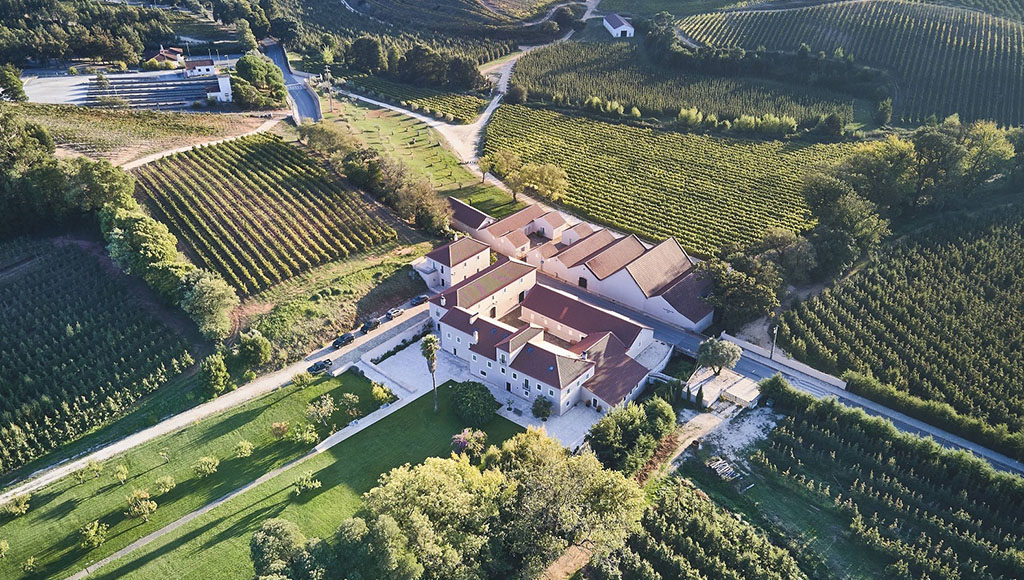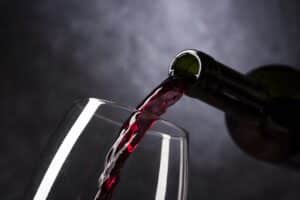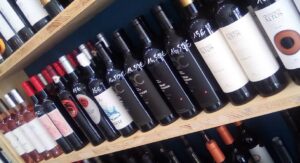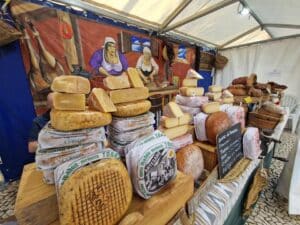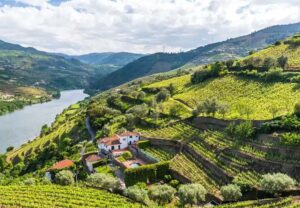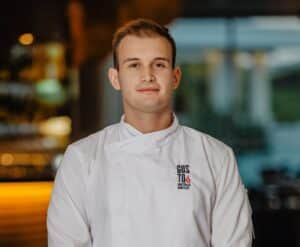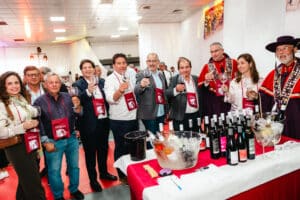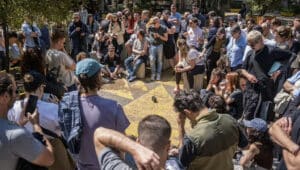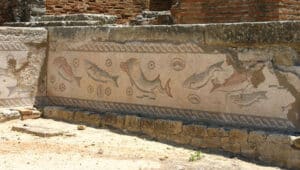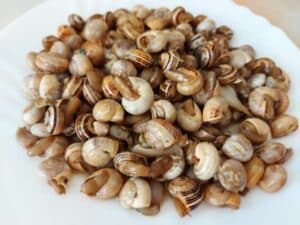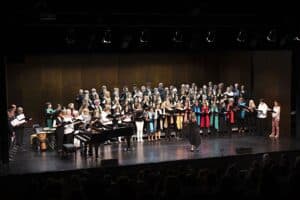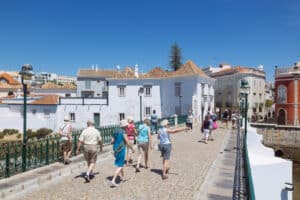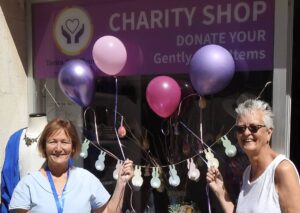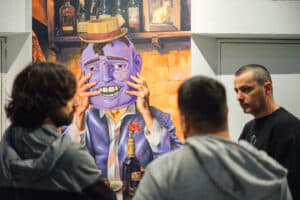I’m a lucky man, for sure. The monthly wine tasting and pairing event that takes place pretty much on my doorstep has given me ‘remote access’ to wines and wineries all over Portugal, paired with extraordinary food, and in the most wonderful company.
Last Friday’s gathering at São Martinho’s Storytellers Palace was no exception; an evening that had me sat with Christine and Jim, fascinating brand new arrivals from the US who, like me, were enthralled by the greatest of evenings that not only began but also ended with some of the finest Portuguese sparkling wine.
Earlier visits to this brilliant venue, offering a rare combination of family-friendliness and five-star ambience, had introduced me to a delightful white wine – Nogueira – which I really enjoyed as the house’s basic, but supremely drinkable vinho branco. The name stayed with me, if only to know how to order it again, but was elevated to a new level of my affections at this remarkable occasion, as I discovered more about its origins and creators.
The fizz I mentioned earlier was the welcoming glass that I enjoyed greatly with my new American buddies, a rosé espumante to be exact, that went down very nicely with some appetisers, notably nibbly chicken satay sticks. Mid-munching and mingling, a customary chinking of empty wine glasses – of which there were plenty in readiness of an evening’s intense tasting – to get our attention introduced the now buzzy and ever-so-slightly boozy bunch to winemaker of the night and distinction, Pedro Barreira.
He began by telling us that quality was of greater importance than quantity at his family’s vineyards, they were organic by way of production methods, and that we were as good as neighbours, with their closest facility just down the road from me, beyond Óbidos. In this engaging and rightly proud opening gambit, we also learned about the great history of their vineyards, one dating back to the 18th century, the other to Roman times, and how this producer used only their own grapes, grown on their own land, in their fine wines.

“During the harvest and in the winery, we adopt a rigorous process for selecting the grapes that we use to produce our wines,” they say. “This is a successive sorting process that ensures that we only select the best grapes.” Here, at Casa Vini Romana, with their Porto Nogueira and Escusa quintas (estates), hand sorting makes sure no rot, leaves, branches, insects or other detritus makes its way into the fermentations, making you wonder what other producers might ‘allow’ into their wines.
This attention to detail at the ‘supply’ end clearly bodes well for good wine and it had me thinking about the other, multiple factors that might make for a truly fine wine, in every detail – factors or criteria which rarely come together in a single bottle or brand. Taste would to me, and no doubt most other wine lovers, be the ultimate marker, but sustainability, ethics, innovation and even design would all need to be well represented in the mix, to make any producer and their produce a purveyor of ultimate standing. And frankly, whilst many, arguably most wines in Portugal, tick one or more of these boxes, I’d given up looking for any that might check them all.
That said, let me tell you more about this maker who emerged at the beginning of this century, with a specific mission to produce “unique and distinctive” wines, and to make a profound impact from their Lisbon and Tejo regional denominations, without compromising on care for the land, and the people and creatures who live upon it.
To give you a greater sense of their place in Portuguese geography, their Quinta do Porto Nogueira estate is located in Alguber, Cadaval, about 70 km north of Lisbon. Here, wine is lovingly made alongside orchards, forests, off-grid energy production and, more recently, a “charming country house”, now open to tourism.
The other, Quinta da Escusa, is located in Senhora da Escusa, in the municipality of Rio Maior, about 70 km northeast of Lisbon, between the villages of Quintas and Vale Barco. Back in the 1920s, some of this estate belonged to the grandparents and parents of the current owners who, for decades, “practiced agriculture and viticulture”. Here too, vineyards are complemented by orchards and forests.
To give you a greater sense of their place in Portuguese history, the centuries-old house of Quinta do Porto Nogueira is located next to a Roman bridge over the Arnóia River, which was the crossing point of the Roman road that connected Collippo (near Leiria) to Eburobrittium (which would become Óbidos) and continued on to Olisipo (the roman name for Lisbon).
“The bridge and the archaeological discovery of an extraordinary Roman Villa in Rio Maior are testament to the presence of the Romans in the region,” say these deeply conscientious and lateral-thinking winemakers, who, inspired by this Latin pedigree, claimed the name Romana Vini.
In another excellent example of their playful integrity and creativity, Casa Romana Vini chose the four-leaf clover as a symbol or motif for the winery and “unifying element of our brands”. “It is a rare herb, a symbol of good omens, whose symbolism dates back to Celtic traditions,” they say. “The four leaves in a cross symbolise the sacred, unity, the balance of nature in its perfect cycle: the four seasons of the year, the four phases of the moon, the four cardinal points, the four elements of nature. It is this balance, this perfect and harmonious cycle of nature that we seek to integrate and reflect in each of our wines.”
They also say: “We strive to be recognized for our meticulousness in making unique wines, respecting each terroir … our wines reflect the true expression of our terroirs. The entire process aims to create true, serious wines with their own identity. We cultivate for quality, not quantity.”
And having sipped, savoured and celebrated a generous cross-section of their wares, this one unforgettable night on the Silver Coast, not far from where they cast and create their magic, I think they have hit the target and ticked every box I mentioned before. Even ecologically. “All the energy consumed in our winery and in tourism is produced at Quinta do Porto Nogueira, from photovoltaic energy production, which ensures our energy self-sufficiency,” they add. “We are a winery that positively offsets, in net terms, all the CO2 impacts generated. To this end, we maintain a permanent afforestation and reforestation program on the land surrounding the winery and vineyards, certified by the Forest Stewardship Council (FSC).”
With wines to dine (sic) for, boasting great taste, structural integrity and innovative flair; production ethics to bow before, and a holistic approach that they, their industry, and even country can be proud of, Casa Romana Vini is what you can call a winery that has it all.
Please find out more – www.romanavini.pt
By Carl Munson
Carl Munson is host of the Good Morning Portugal! show every weekday on YouTube and creator of www.learnaboutportugal.com, where you can learn something new about Portugal every day!


